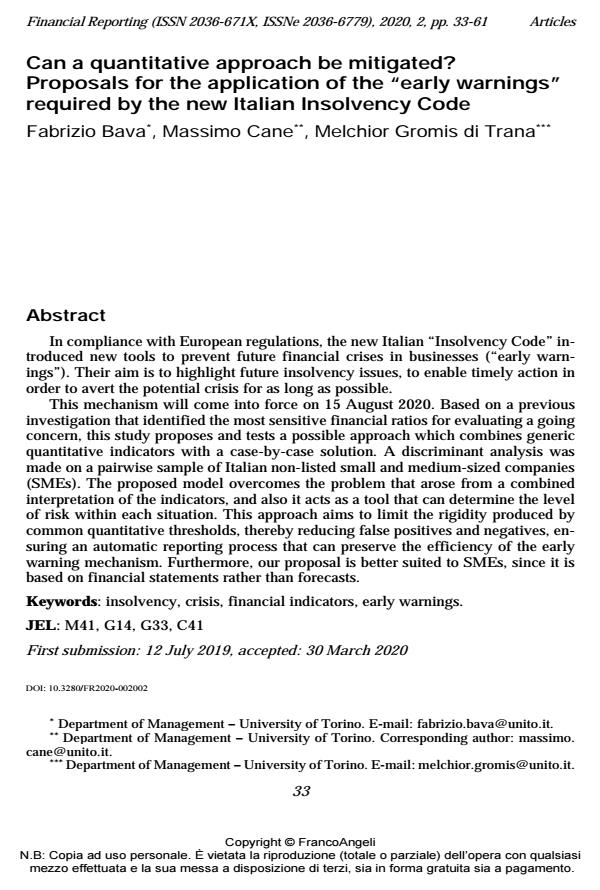Can a quantitative approach be mitigated? Proposals for the application of the "early warnings" required by the new Italian Insolvency Code
Titolo Rivista FINANCIAL REPORTING
Autori/Curatori Fabrizio Bava, Massimo Cane, Melchior Gromis di Trana
Anno di pubblicazione 2020 Fascicolo 2020/2
Lingua Inglese Numero pagine 29 P. 33-61 Dimensione file 449 KB
DOI 10.3280/FR2020-002002
Il DOI è il codice a barre della proprietà intellettuale: per saperne di più
clicca qui
Qui sotto puoi vedere in anteprima la prima pagina di questo articolo.
Se questo articolo ti interessa, lo puoi acquistare (e scaricare in formato pdf) seguendo le facili indicazioni per acquistare il download credit. Acquista Download Credits per scaricare questo Articolo in formato PDF

FrancoAngeli è membro della Publishers International Linking Association, Inc (PILA)associazione indipendente e non profit per facilitare (attraverso i servizi tecnologici implementati da CrossRef.org) l’accesso degli studiosi ai contenuti digitali nelle pubblicazioni professionali e scientifiche
In compliance with European regulations, the new Italian "Insolvency Code" introduced new tools to prevent future financial crises in businesses ("early warn-ings"). Their aim is to highlight future insolvency issues, to enable timely action in order to avert the potential crisis for as long as possible.V This mechanism will come into force on 15 August 2020. Based on a previous investigation that identified the most sensitive financial ratios for evaluating a go-ing concern, this study proposes and tests a possible approach which combines generic quantitative indicators with a case-by-case solution. A discriminant analysis was made on a pairwise sample of Italian non-listed small and medium-sized companies (SMEs). The proposed model overcomes the problem that arose from a combined interpretation of the indicators, and also it acts as a tool that can deter-mine the level of risk within each situation. This approach aims to limit the rigidity produced by common quantitative thresholds, thereby reducing false positives and negatives, ensuring an automatic reporting process that can preserve the efficiency of the early warning mechanism. Furthermore, our proposal is better suited to SMEs, since it is based on financial statements rather than forecasts.
Parole chiave:Insolvency, crisis, financial indicators, early warnings.
Jel codes:M41, G14, G33, C41
- Early Warning Systems for financial crises prediction in private companies: Evidence from the Italian context Mario Daniele, Elisa Raoli, in FINANCIAL REPORTING 2/2024 pp.133
DOI: 10.3280/FR2024-002006 - Early warning detection using Logic Learning Machine: Evidence from private firms Enrico Ferrari, Roberto Garelli, Alessandro Limon, Alessandro Piazza, Lorenzo Simoni, Damiano Verda, in FINANCIAL REPORTING 1/2025 pp.21
DOI: 10.3280/fr202516015
Fabrizio Bava, Massimo Cane, Melchior Gromis di Trana, Can a quantitative approach be mitigated? Proposals for the application of the "early warnings" required by the new Italian Insolvency Code in "FINANCIAL REPORTING" 2/2020, pp 33-61, DOI: 10.3280/FR2020-002002